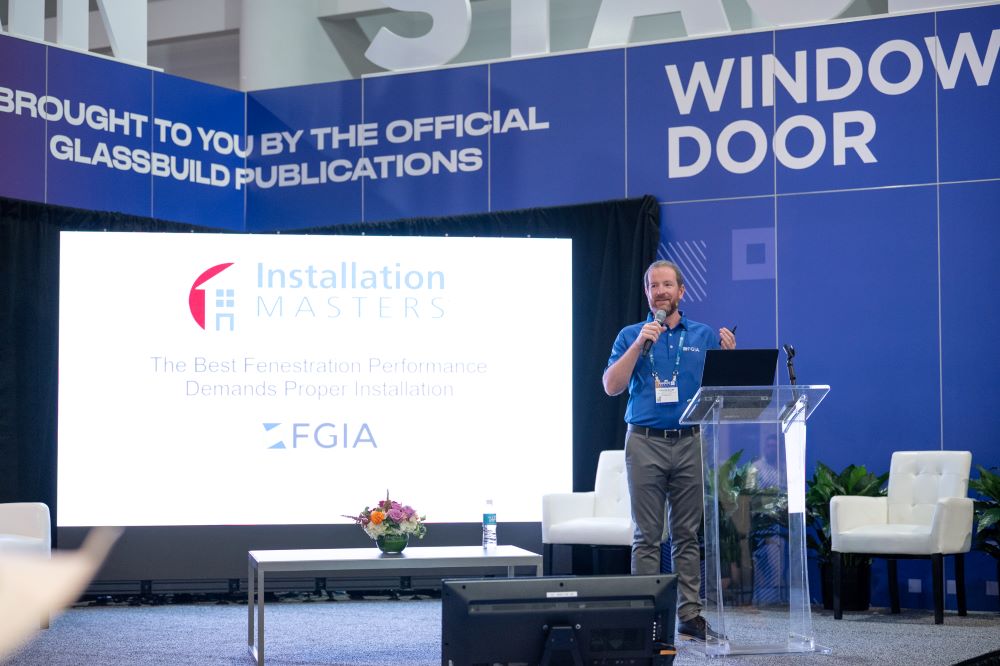Curtain Wall Basics
5 design considerations, and performance and testing requirements

Above: Aaron Blom presenting during GlassBuild America 2022
Editor’s Note: The following is based on the education session “Curtain Walls | Design Considerations, Tolerances and Testing,” presented by Blom at GlassBuild America, held Oct. 18-20, 2022, in Las Vegas. Find more news and coverage from the show.
In its basic form, a curtain wall system consists of insulating glass and extruded aluminum framing either installed piece by piece in the field (stock lengths), or installed using pre-assembled, pre-glazed framing and glass panels (unitized). Hybrid versions include various system options and fabrication and installation techniques that can be used to achieve specific design aesthetics as well as maximize fabrication and installation efficiency.
Regardless of the installation methods used, curtain wall systems must address five primary design considerations: structural integrity, movement capability, weathertightness, energy efficiency and sound control.
Structural integrity
As with all types of fenestration, wind load is an important structural consideration for curtain wall systems. The more the frame deflects due to the design wind load, the more stress is placed on the assembly and the greater the likelihood of system failure and/or glass breakage. The engineering calculation used to determine maximum vertical framing deflection is L/175 for spans up to 13 feet 6 inches and L/240 + ¼-inch for spans that are greater, where L is the vertical span length. Other structural performance considerations include live load, dead load, seismic and inter-story drift.
Provision for movement
There are multiple factors to consider when designing a curtain wall system to accommodate expected movement, including thermal expansion and contraction, movement due to wind load and gravitational forces, and movement caused by deformation or displacement of the building. Movement must be accommodated to limit the stress on the glass, framing and anchors, and without excessively reducing the frame’s “bite” or capture of the glass.
Weathertightness
Weathertightness means protection against both air and water leakage.
Water penetration. There are two methods for preventing water leakage through a curtain wall system. One is the “internal drainage” system utilizing weep holes in the pressure plate and face cap. The other is achieved through "pressure equalization" of the system. Basically, a pressure-equalized design ensures there is not a significant negative pressure pulling water into the system from the exterior.
Air infiltration. For obvious reasons, excessive air infiltration is less critical than water penetration but can compromise the energy efficiency of the building envelope. Industry standards limit air infiltration to 0.3 liters per second air leakage per square meter of fixed wall area (0.06 cubic feet per minute per square foot of area) when tested at an air pressure difference of 1.57 pound-force per square foot.
Energy efficiency
Curtain wall systems must meet an overall maximum thermal transmittance or U-Factor (W/m2•K or Btu/hr•ft2•°F) stipulated by applicable codes based on project location and other project-specific thermal performance requirements. Improved thermal performance can be accomplished in multiple ways, including using thermally broken framing materials, using high-performance insulating glass and adequately insulating large spandrel areas. ডাউনলোড এখানে গ্লোরি ক্যাসিনো অ্যাপ ডাউনলোড . Glory casino বাংলাদেশের জন্য।
Sound control
Sound Transmission Class (STC) and Outdoor/Indoor Transmission Class (OITC) are the standard methods for rating sound attenuation of glass and window systems. Using laminated insulating glass, using insulating glass with an increased airspace and minimizing air infiltration will generally improve sound transmission—of particular concern near airports and in metropolitan areas.
Performance and testing requirements
Due to the wide range of forces that act upon a building in a particular location, physical testing for air infiltration, water penetration and structural performance (including frame deflection limits) is often the only reliable means of verifying performance in field conditions. This testing may be conducted on stand-alone mock-ups or on completed installations, also called in-place mock-ups.

